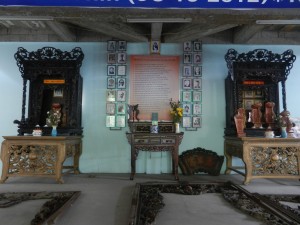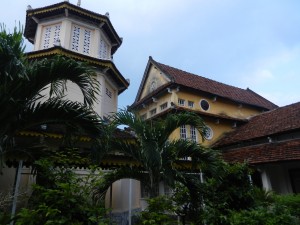Many followers of the Cao Dai religion see it as the great universal religion of today, which can bring harmony between all the world’s faiths. Others see it as a mishmash–it cuts and pastes pieces of several religions without saying anything original.
We’ll look into inner workings of the faith and see what makes it unique.
Here are some more facts about the Cao Dai religion:
1. Caodaiism believes that everyone’s soul came from the Supreme Being, and that all living beings share the same inner spiritual nature. The goal of the faith is to realize our oneness with God and with all life on earth.
Nice, but isn’t this a New Age cliche? There’s the riddle: What did the Hindu mystic say to the hot dog vendor? Make me one with everything!
And didn’t 1960’s hippies say the same thing between bong hits?
Maybe (I was too young back then to know), but the Cao Dai faith has more depth and discipline.
2. Ideally people worship the Supreme Being at least once a day at home and twice a month at a local temple.
There are 4 daily ceremonies: 6:00 AM, noon, 6:00 PM and midnight.
3. According to Hum Dac Bui, in Cao Dai; Faith of Unity, Caodaists traditionally bring their hands together so that the left represents yang, the active energies in nature, and the right hand is yin, the receptive patterns in nature. The end of the left thumb touches the base of the left ring finger, and the other left fingers wrap around the thumb. The right hand wraps around the left hand so that the tip of the right thumb touches the base of the left index finger. So both hands join into a microcosm of the Cao Dai universe–all energies are balanced and they circulate smoothly within a unified cosmos. This idea was influenced by Daoist cosmology from China.
Worshipers thus embody universal harmony. They then proceed through a series of salutations to the altar and each other, and they pray to the Supreme Being.
4. But Cao Dai is more than a ritual. It has esoteric aspects. Its followers believe that highly evolved spirits remain in contact with us when they leave this world, and that they stay in touch with the living to promote universal harmony. The Cao Dai temple I visited in Ho Chi Minh city had several altars, including the one in the above photo with pics of many of the faith’s founding fathers.
Since ancient times, Southeast Asian societies saw the spiritual landscape as pluralistic–ancestors and nature spirits populated a very lively universe. The Cao Dai faith accommodates this traditional world-view by allowing revered figures, even the 19th century French poet Victor Hugo, to mediate between us and the Supreme Being.
5. The Cao Dai faith also honors the feminine principle in nature, and identifies it with Yin. The above shot is from the same Ho Chi Minh City Cao Dai temple. The graceful goddess with her own shrine is Quan Am. She’s more widely known by her Chinese name, Quan Yin, and she embodies the Buddha’s compassion.
So though the Cao Dai faith has prescribed rituals, temples where everyone gathers, and a centralized hierarchy, it also has a lot of flexibility. Believers can be herd-like and do the same rituals. Or they can meditate and commune with spirits. Or they can be devotional and worship a compassionate goddess. Caodaiism teaches that there is one Supreme Being and that all the world is unified in it. But it allows room for many ways of worshiping it, as long as they encourage love and justice for all beings.
This flexibility is very Southeast Asian. Caodaiism stresses harmony between multiple mindsets, rather than one ideology. The faith reflects this region and Vietnam–it blends ideas and art forms in an endless variety of ways that add beauty to the world and help make people more tolerant. I’m not qualified to say if Cao Dai is a great religion from a theological standpoint. But from a cultural perspective, the eyes have it.






Comments on this entry are closed.